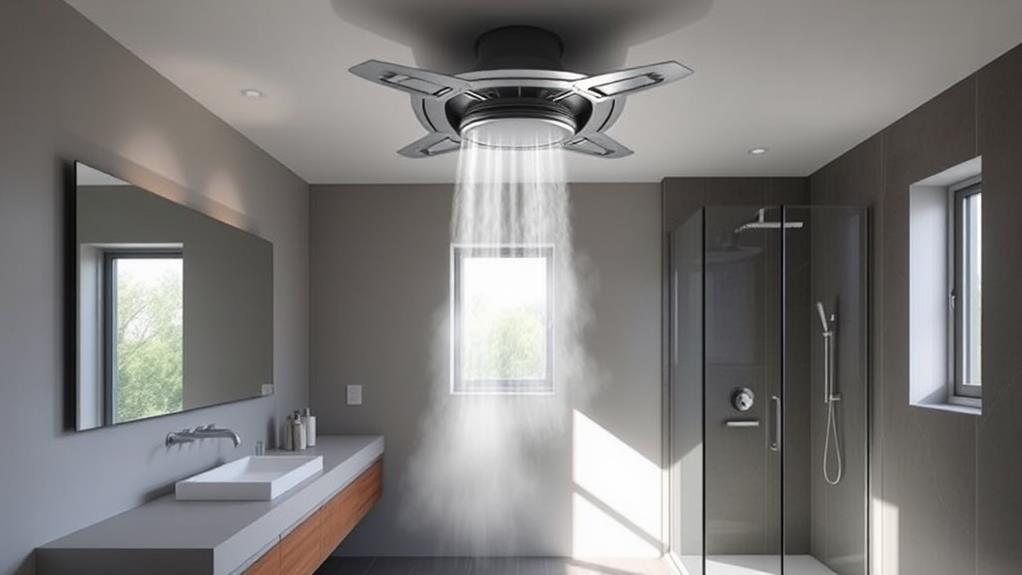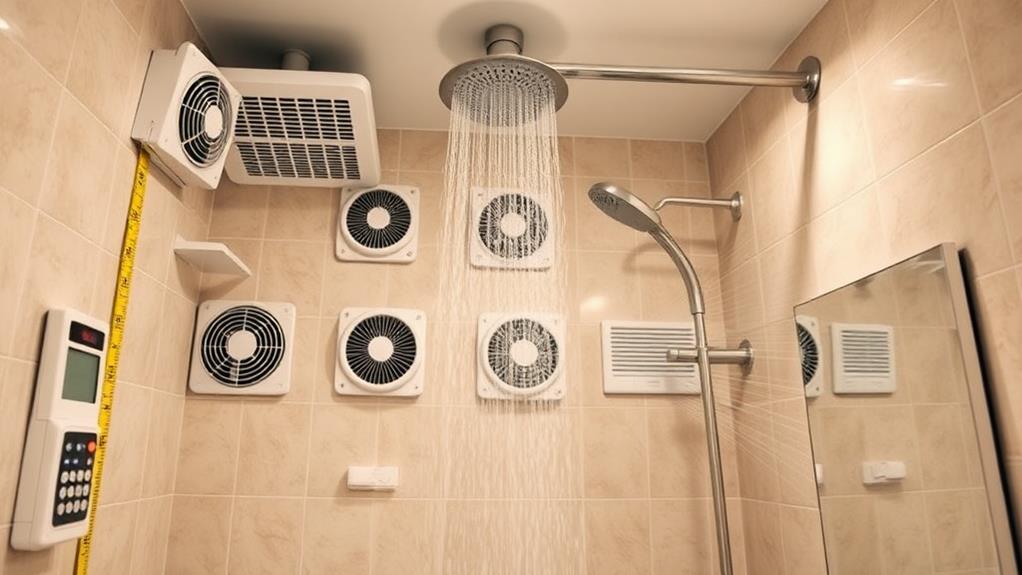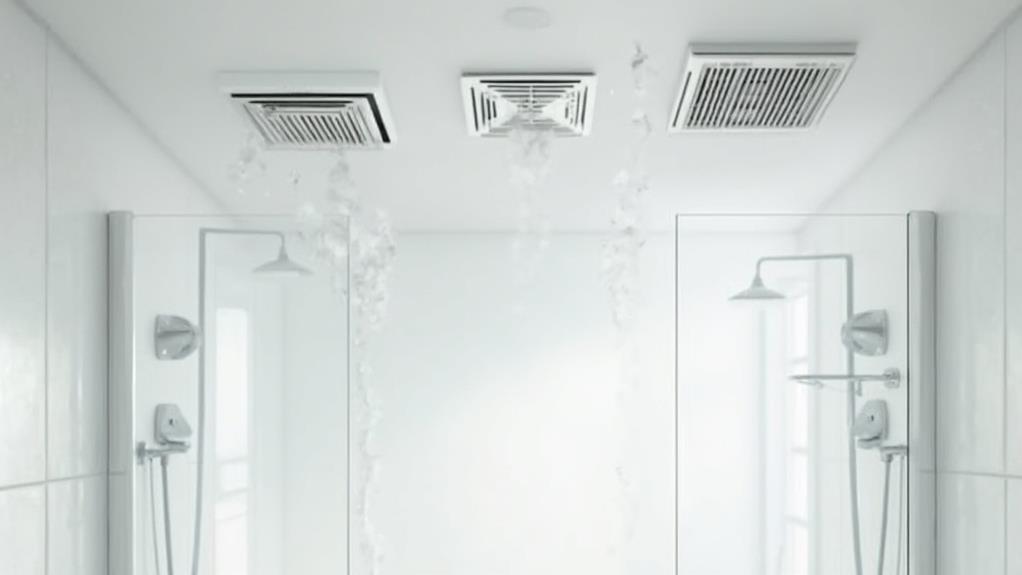When choosing an exhaust fan for your bathroom, consider its capacity measured in CFM (Cubic Feet per Minute). As a general rule, you'll need 1 CFM per square foot for standard bathrooms. Measure your bathroom's length, width, and height to calculate the required CFM. For larger bathrooms or those with high ceilings, add 50 CFM per toilet, shower, or bathtub. Look for fans with slightly higher capacity to ensure proper ventilation. Don't forget to factor in noise levels (measured in sones) and energy efficiency. By understanding these key aspects, you'll be well-equipped to select the perfect exhaust fan for your space.
Understanding Bathroom Fan Capacity

When selecting a bathroom exhaust fan, understanding its capacity is crucial. Fan capacity is measured in cubic feet per minute (CFM), which indicates how much air the fan can move in one minute. To determine the right CFM for your bathroom, you'll need to calculate its size in square feet.
For standard bathrooms, the general rule is to have 1 CFM per square foot. So, if your bathroom is 80 square feet, you'll need a fan with at least 80 CFM. However, if your bathroom has high ceilings or multiple shower heads, you'll want to increase the CFM accordingly.
For bathrooms larger than 100 square feet, add 50 CFM for each toilet, shower, or bathtub, and 100 CFM for a whirlpool tub. Don't forget to consider other factors like window placement and how often the bathroom is used.
It's better to choose a fan with slightly higher capacity than you need rather than one that's underpowered. An inadequate fan won't effectively remove moisture and odors, which can lead to mold growth and poor air quality. By understanding fan capacity, you'll ensure proper ventilation for your bathroom.
Measuring Your Bathroom Space
To accurately determine the right exhaust fan capacity, you'll need to measure your bathroom space correctly. Start by measuring the length and width of your bathroom floor in feet. Multiply these two numbers to get the square footage. For irregularly shaped bathrooms, divide the space into rectangles, calculate each area separately, and add them together.
Next, measure the height of your bathroom from floor to ceiling. This is crucial for calculating the room's volume, which affects the fan's effectiveness. Multiply the square footage by the height to get the cubic footage.
Don't forget to include any adjoining spaces that aren't separated by a door, such as a water closet or dressing area. These areas contribute to the total volume that needs ventilation.
If you have a sloped ceiling, measure the average height by taking measurements at the highest and lowest points, then finding the middle value. For vaulted ceilings, consult a professional to ensure accurate calculations.
Remember to measure openings like windows or doorways, as these can impact airflow and fan requirements. By taking precise measurements, you'll be well-equipped to choose the right exhaust fan for your bathroom's specific needs.
Calculating Required CFM

Precision is key when calculating the required CFM (Cubic Feet per Minute) for your bathroom exhaust fan. To determine the appropriate CFM, you'll need to consider your bathroom's square footage and ceiling height. Start by multiplying the length and width of your bathroom to get the square footage. For standard 8-foot ceilings, the general rule is to allow 1 CFM per square foot. So, if your bathroom is 100 square feet, you'd need a 100 CFM fan.
For bathrooms with higher ceilings, you'll need to adjust your calculations. Add 50 CFM for every foot above 8 feet. For instance, if your bathroom has a 10-foot ceiling, you'd add 100 CFM to your base calculation.
Don't forget to factor in additional features like a jetted tub or multiple shower heads, which may require extra ventilation. For these, add 50-100 CFM to your total.
Remember that it's better to slightly oversize your fan than to undersize it. A fan with higher CFM will effectively remove moisture and odors, ensuring a well-ventilated bathroom. Once you've calculated your required CFM, you can confidently choose an exhaust fan that meets your bathroom's specific needs.
Noise Level Considerations
Noise level is a crucial factor to consider when selecting a bathroom exhaust fan. The sound produced by these fans is measured in sones, with lower numbers indicating quieter operation. For a peaceful bathroom environment, aim for fans rated at 1.0 sone or less.
You'll find that most modern exhaust fans range from 0.3 to 4.0 sones. Ultra-quiet fans (0.3 to 0.8 sones) are ideal for master bathrooms or any space where noise sensitivity is high. Standard fans (1.0 to 2.0 sones) work well in most situations, while economy models (2.0 to 4.0 sones) are better suited for less frequently used bathrooms.
Consider your bathroom's location and usage when selecting fan noise levels. If it's near bedrooms or living areas, opt for quieter models. For powder rooms or guest bathrooms, you may tolerate slightly higher noise levels. Remember that higher CFM ratings often correlate with increased noise, so balance your ventilation needs with acceptable sound levels. Some fans offer multiple speed settings, allowing you to adjust both airflow and noise as needed. By prioritizing noise considerations, you'll ensure a more comfortable and relaxing bathroom experience.
Energy Efficiency Factors

Energy efficiency is a key factor when choosing a bathroom exhaust fan. You'll want to look for fans with ENERGY STAR certification, as these models use about 70% less energy than standard fans. This translates to lower electricity bills and reduced environmental impact.
Pay attention to the fan's CFM (cubic feet per minute) rating. While you need sufficient airflow to remove moisture effectively, an oversized fan will waste energy. Calculate the appropriate CFM for your bathroom size to ensure optimal efficiency.
Consider fans with DC motors, which are typically more energy-efficient than AC motors. They're quieter and often have adjustable speeds, allowing you to use only the power you need.
Look for fans with built-in humidity sensors. These automatically turn on when moisture levels rise and shut off when they return to normal, preventing unnecessary operation and energy waste.
Some models come with timer functions, ensuring the fan runs only as long as needed. This feature is particularly useful if you often forget to turn off the fan manually.
Lastly, check the fan's sones rating. Lower sones indicate a quieter operation, which might encourage you to run the fan for the appropriate duration without the temptation to switch it off prematurely due to noise annoyance.
Installation and Placement Tips
Once you've selected an energy-efficient fan, proper installation and placement are key to maximizing its performance. Install your exhaust fan near the shower or bathtub, where moisture concentration is highest. Ideally, position it on the ceiling, no more than 5 feet from the shower's edge. If ceiling installation isn't possible, wall-mounted fans are an alternative, but they're generally less effective.
Ensure your fan vents directly outside, never into an attic or crawl space. Use rigid metal ductwork with minimal bends to reduce airflow resistance. Keep duct runs as short as possible, ideally under 10 feet. Insulate ducts in unconditioned spaces to prevent condensation.
When installing, seal all duct connections with mastic or foil tape to prevent leaks. Use a dedicated switch for the fan, separate from the bathroom light. Consider a timer or humidity-sensing switch for automatic operation.
For larger bathrooms, you might need multiple fans or a single fan with multiple intake grilles. In this case, place intakes strategically to cover all moisture-prone areas. Remember to follow local building codes and manufacturer instructions throughout the installation process.
Conclusion
You're now equipped with the knowledge to select a bathroom exhaust fan that'll transform your space into a mist-free oasis. Remember, the right CFM rating is crucial, but don't forget about noise levels and energy efficiency. With proper installation and placement, you'll have a fan that's practically invisible yet incredibly effective. So go ahead, choose wisely, and enjoy the fresh, clean air in your bathroom for years to come.

